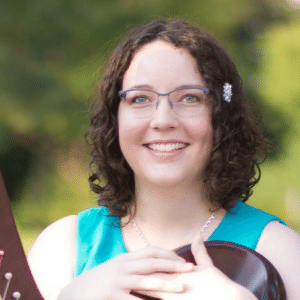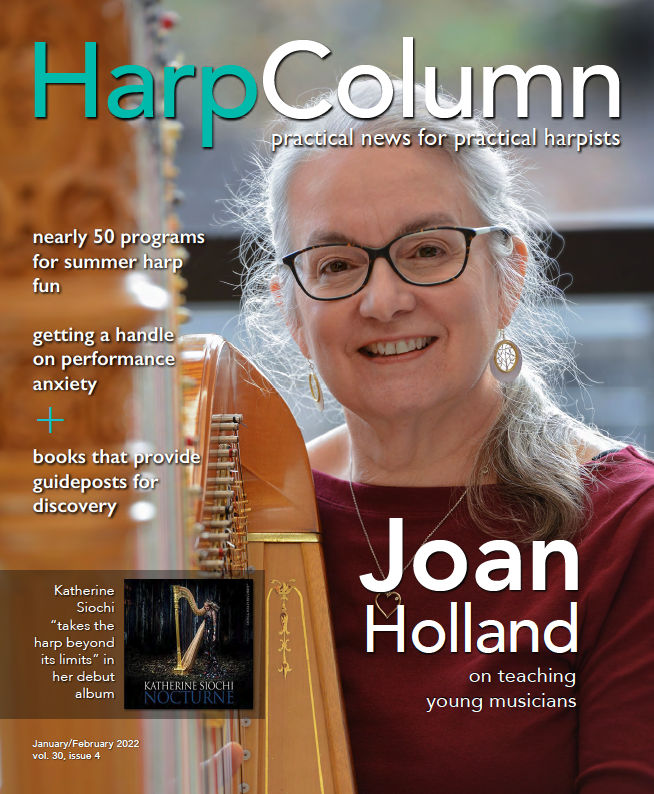Editor’s note: This is the final installment of Get Booked, our four-part series where author Heather Cornelius explores music-related books. The entire series is available to read here.
As you look ahead to the new year, equip your teaching studio with children’s books for younger students. Expand your knowledge with music resources, and prepare to enjoy the journey of discovery.
Children’s books
If you have young students, these children’s books will capture their imagination, giving them a new way to discover music. The following titles make great additions to your studio.
When harpist Pamela Golkin was 9 years old, she wrote and illustrated Emmet Owl Plays the Harp. Emmet Owl’s experiences will resonate with any young harpist. “It is such a sweet story,” says Angela Schwarzkopf, who suggests creating a soundtrack with your students. “First, I read them the book, and we pick key words that are repeated, and create specific sound effects on the harp that go with those words. Then I read the book again, while the students play the sound effects every time the words are spoken. It is always so much fun, and this book is regularly a hit!”
I heard about Teresa Bateman’s book Harp O’Gold from Shari Latz Rothman. This tale of a minstrel in a faraway land has surprising similarities to a harp student’s life: the challenge of dreams that don’t come true, and the reward of discovering something even more worthwhile. Jill Weber’s illustrations are full of expressive characters; it was fun to imagine what they might be thinking and feeling as the story progressed.
The Adventures of a Harp Mouse by Diane Dunn was one of my favorite children’s books about the harp when I was young. It offers a peek into the insides of a harp, where a gentle mouse rides along on countless exciting journeys to a freelance harpist’s gigs.
The warm, lifelike illustrations by Linda Carollo Endres are perfectly suited to the tender warmth of the story. Carollo Endres captures everything from a delicious slice of wedding cake to the pedal bars inside the base of a harp. I loved the illustrations, and the story offers a fresh new take on the performer’s lifestyle.
Dunn has also written two other books in the series. The Harp Mouse Chooses Her Home: The Adventure Begins, illustrated by Donna Pellegata, tells how a field mouse discovers a harp maker’s workshop and falls in love with the instrument. Dunn’s and Pellegata’s most recent book is titled Harp Mouse Adventures II.
As a child, I loved Barbara Nichol’s story of Beethoven, accompanied by Scott Cameron’s beautiful paintings. Beethoven Lives Upstairs is a series of letters between a 10-year-old boy and his uncle. Gradually, the boy’s frustrations and misunderstandings lead to a revelation of Mr. Beethoven’s character and his beautiful music.
My first introduction to music history was through the Great Musicians series by Opal Wheeler and Sybil Deucher. Their writing drew me in, and got me interested in the great composers as living people with personalities and life stories. Wheeler’s and Deucher’s colorful writing gave me valuable context for later when I was ready to learn more about their greatest works. In addition to the text, each book includes short musical pieces for keyboard, which are also included on the audio CDs for each composer. The series includes the following composers: Johann Sebastian Bach, Ludwig Beethoven, Johannes Brahms, Frédéric Chopin, Stephen Foster, George Frederic Handel, Franz Joseph Haydn, Edward MacDowell, Wolfgang Amadeus Mozart, Niccolò Paganini, Franz Schubert, Robert Schumann, Peter Tchaikovsky, and Richard Wagner. These books are a great way to meet the composers and understand their music.
Musicians’ resources
Resources are like guideposts on a hiking trail. They orient us to the world of music and are always there when we need to find our place. The following resources point the way for practicing and studying music, working with composers, maintaining your harp, and building your career.
Music dictionaries: The Harvard Dictionary of Music, edited by Don Randel, is a one-volume encyclopedia of musical forms and styles, instruments, history, and performance indications. It’s an informative and well-written guide to the building blocks of music. If you’re looking for a pocket-sized dictionary, The A to Z of Foreign Musical Terms by Christine Ammer has just about everything you’ll need for score study. It also comes with thorough pronunciation guides for Italian, French, and German.
References for composers: Harpists’ guides to their instrument are essential tools for helping composers to write music well-suited to the harp. Writing for the Pedal Harp: A Standardized Manual for Composers and Harpists, by Ruth K. Inglefield and Lou Anne Neill, aims to spark creative ideas for merging the composer’s musical vision with harpistic colors, articulations, and effects. Inglefield and Neill also offer advice for incorporating elements of drama, chance or improvisation, and electronics. Although their 1985 book contains some references to tape and other older technologies, the compositional advice they offer is still an excellent doorway to inspiration.
Yolanda Kondonassis’ 2019 book The Composer’s Guide to Writing Well for the Modern Harp gives practical, clear, and thorough advice for composers. Kondonassis writes in a conversational style, and includes musical examples with suggested notation. Kondonassis provides background material on the structure and mechanics of the harp, as well as detailed descriptions of physical limitations, such as stretches between fingers. She includes examples of chords and patterns that are impossible to play, with potential solutions. Thirty idiomatic patterns and a chart of comfortable three- and four-finger chords are also provided, to start the composer’s thinking in the right direction.
These two harp composition manuals clearly lay out the limitations and strengths of the instrument, and they offer standardized notational symbols for a wide range of special effects. Both guides are excellent resources for harpists and the composers they work with.
A harp maintenance guide is always good to have on hand. Check out Carl Swanson’s A Guide for Harpists: Care, Maintenance, and Repair of the Pedal Harp, or if you’re a lever harpist, try Troubleshooting Your Lever Harp by David Kolacny.
If the business side of music seems intimidating, you might find a wonderful resource in Beyond Talent: Creating a Successful Career in Music (3rd ed.) by Angela Beeching, which was recommended to me by arranger, composer, and teacher Linda Wood Rollo. It’s easy to understand and full of templates, step-by-step checklists, stories, and examples that will help you find your way to building a larger audience. Topics covered include how to connect authentically with your audience, how to book concerts, what to include in your press kit, how to design your website, how to apply for grants, and how to watch for opportunities to expand your career.
Discovery of music comes in many forms. The books I read as a child helped to fuel my enthusiasm by giving me a background for the music I played. As I grew older, I had questions about the pieces I was learning. I found out that resources like music dictionaries could help me understand style and foreign terms, and I learned how to effectively work with composers and arrange music for harp. Reading about other musicians’ lives has clarified my own goals, and helped me understand the deeper purpose of music. As I read, I’m inspired to follow the harpists who have gone before me. Books help me gain a new mindset and a better understanding of myself and others. I hope you, too, will find these books to be a helpful guide to your journey as a musician. •



















